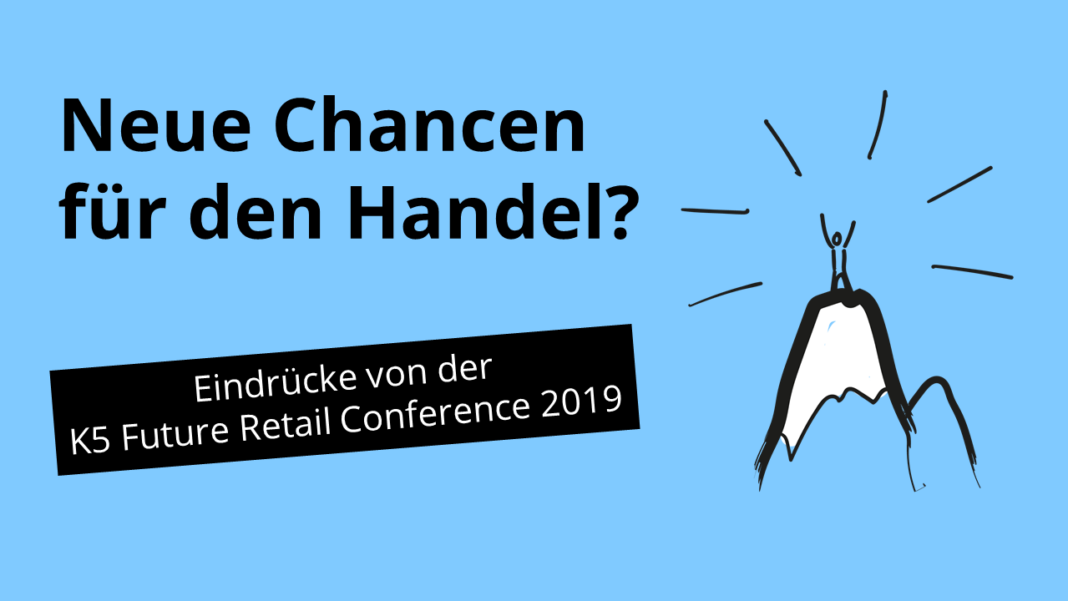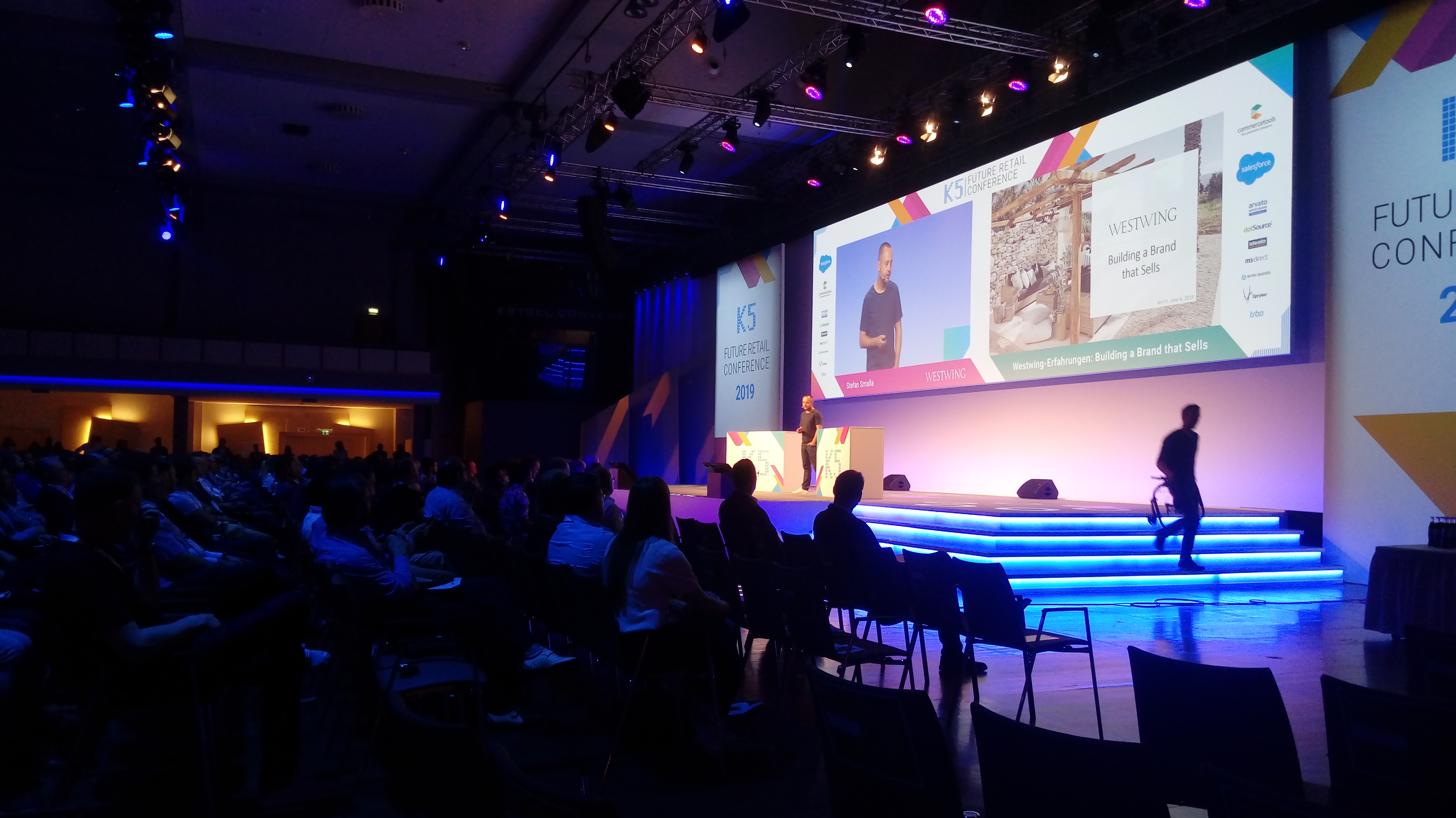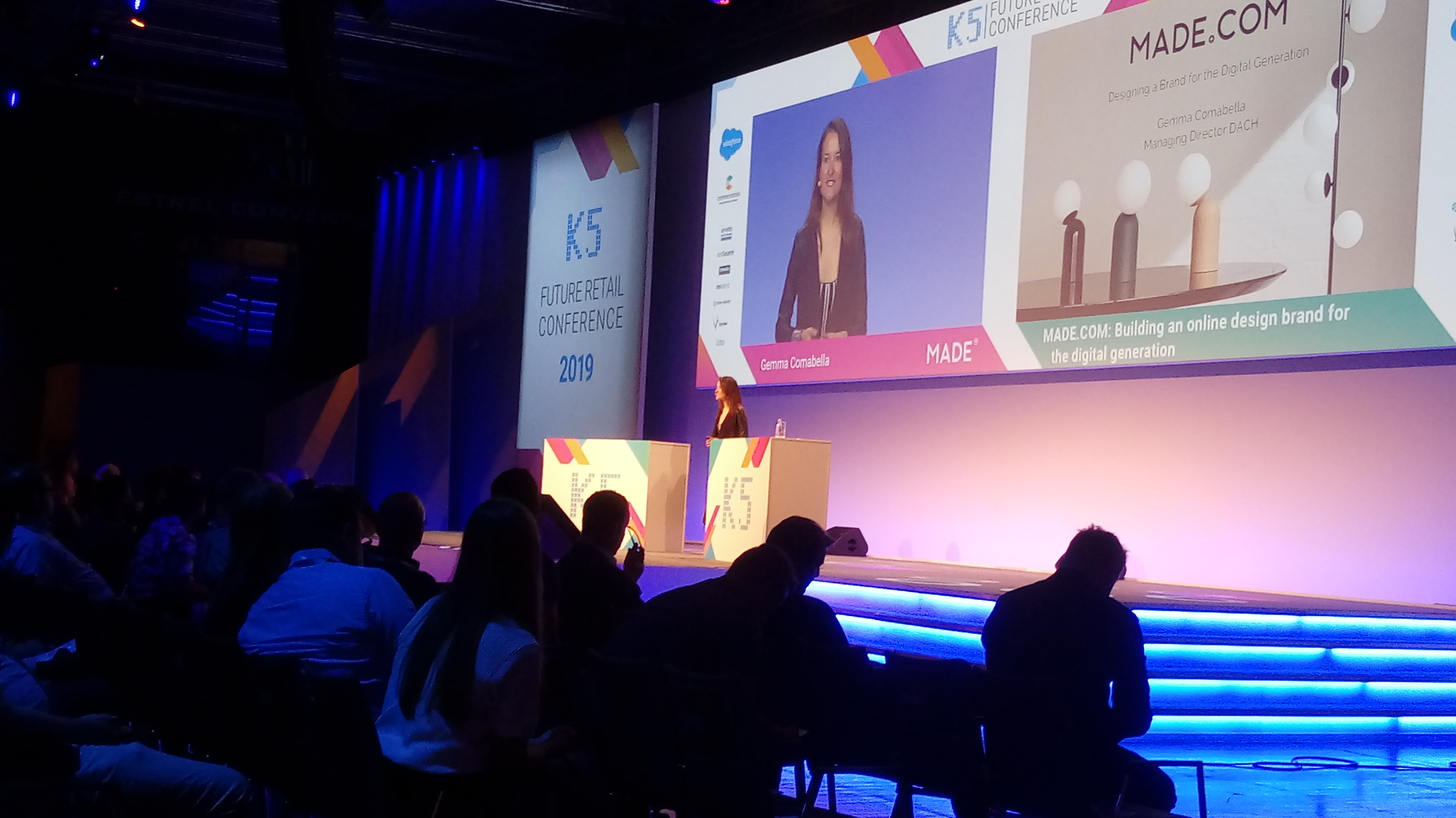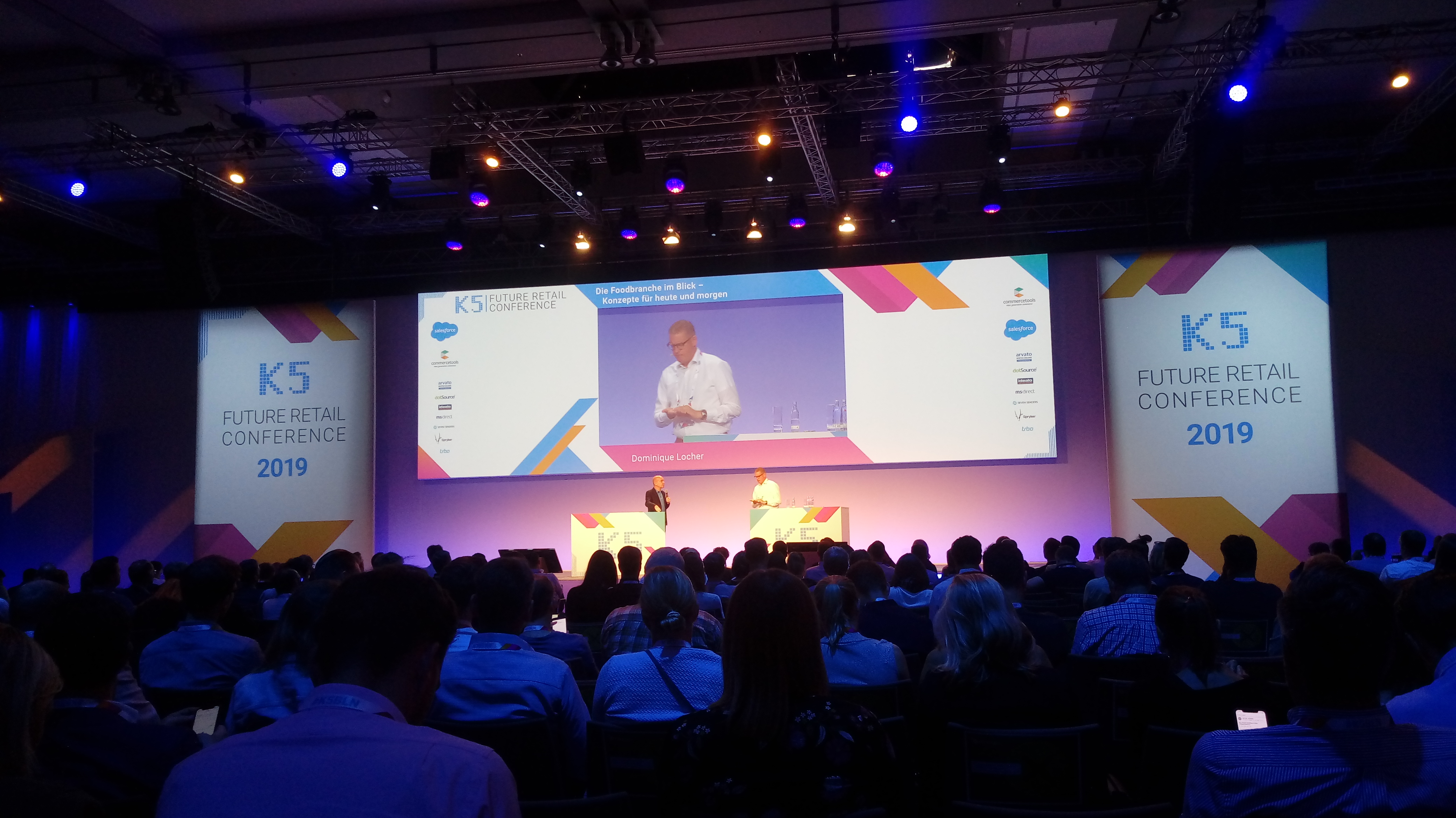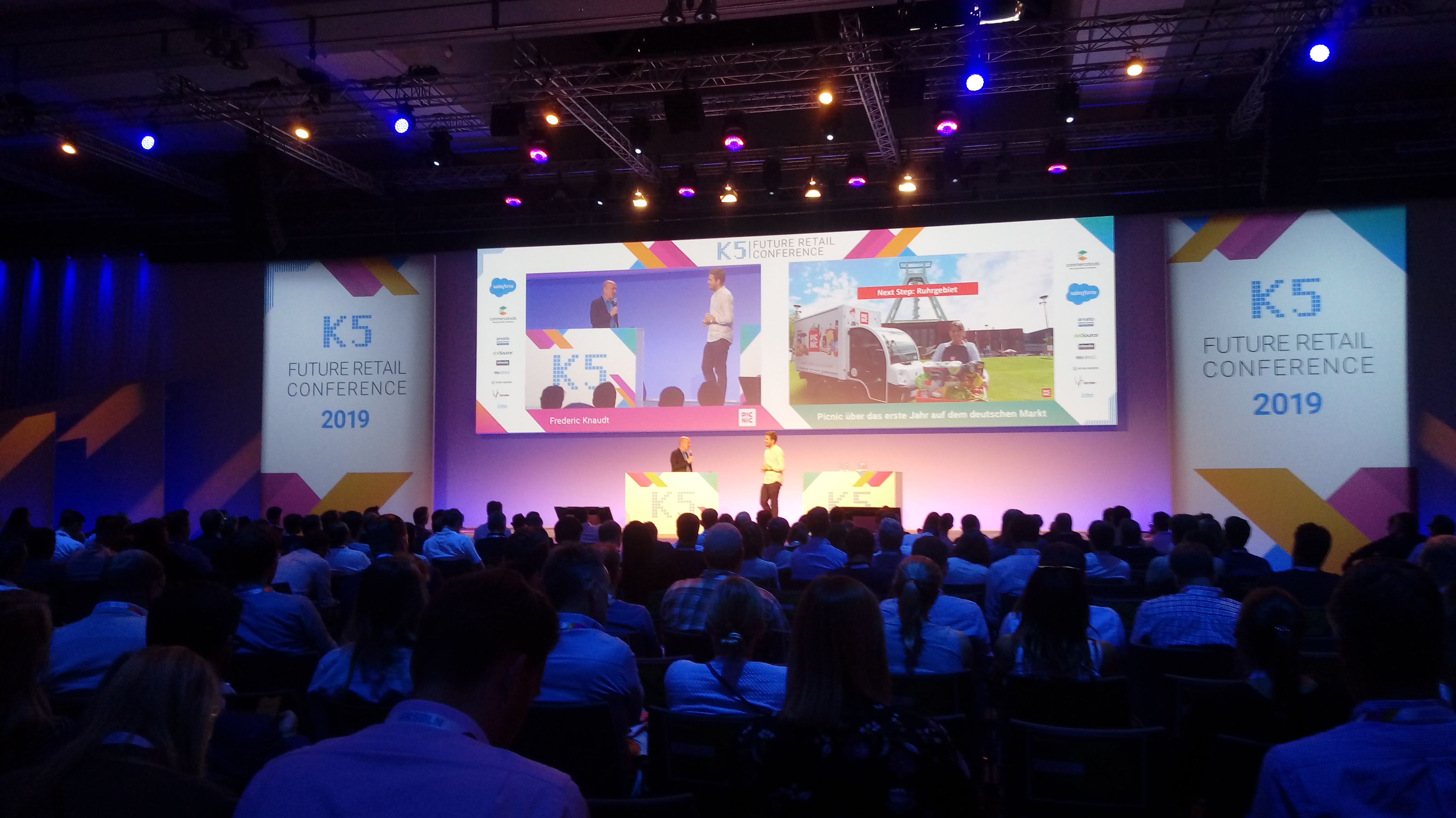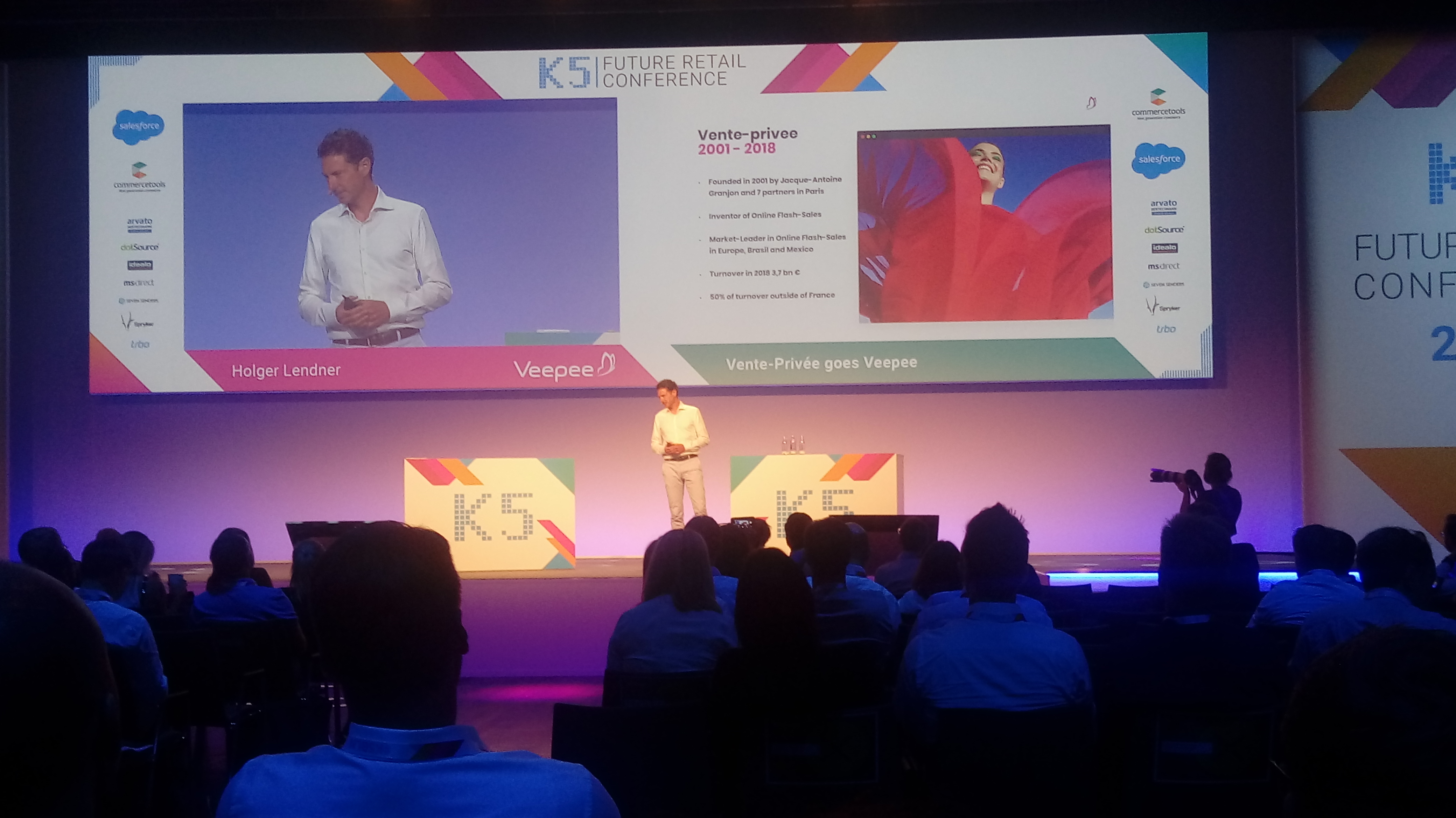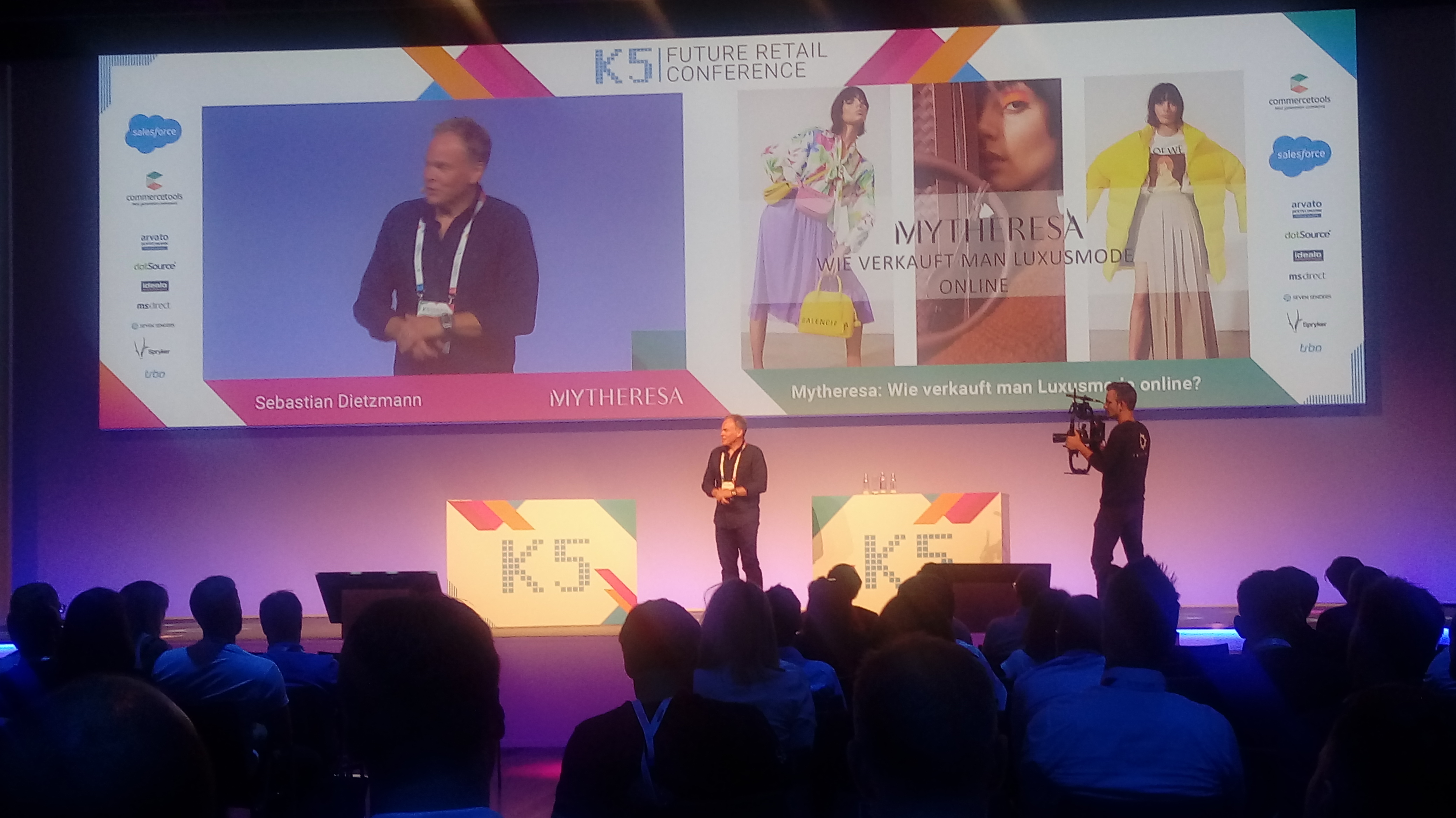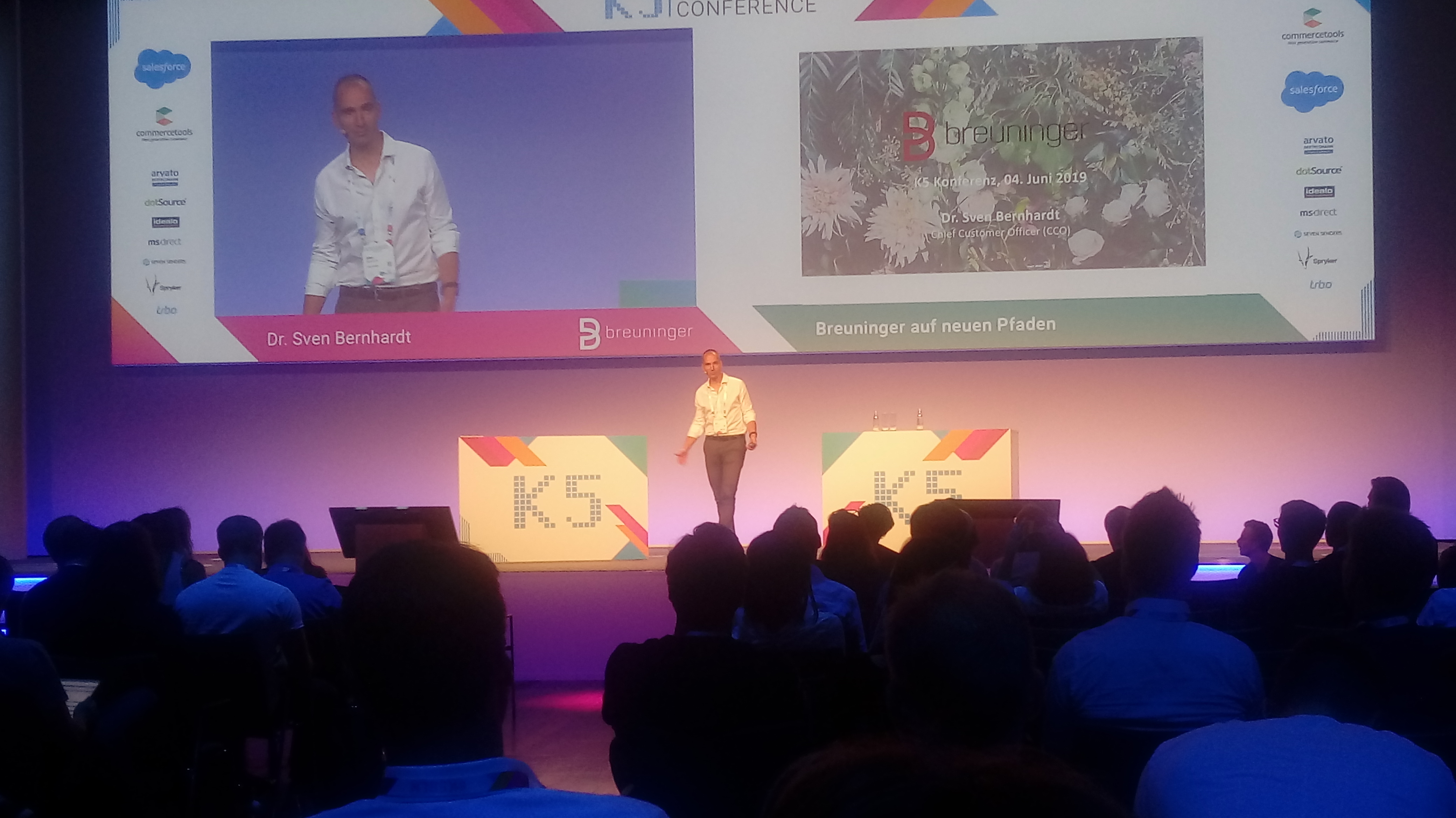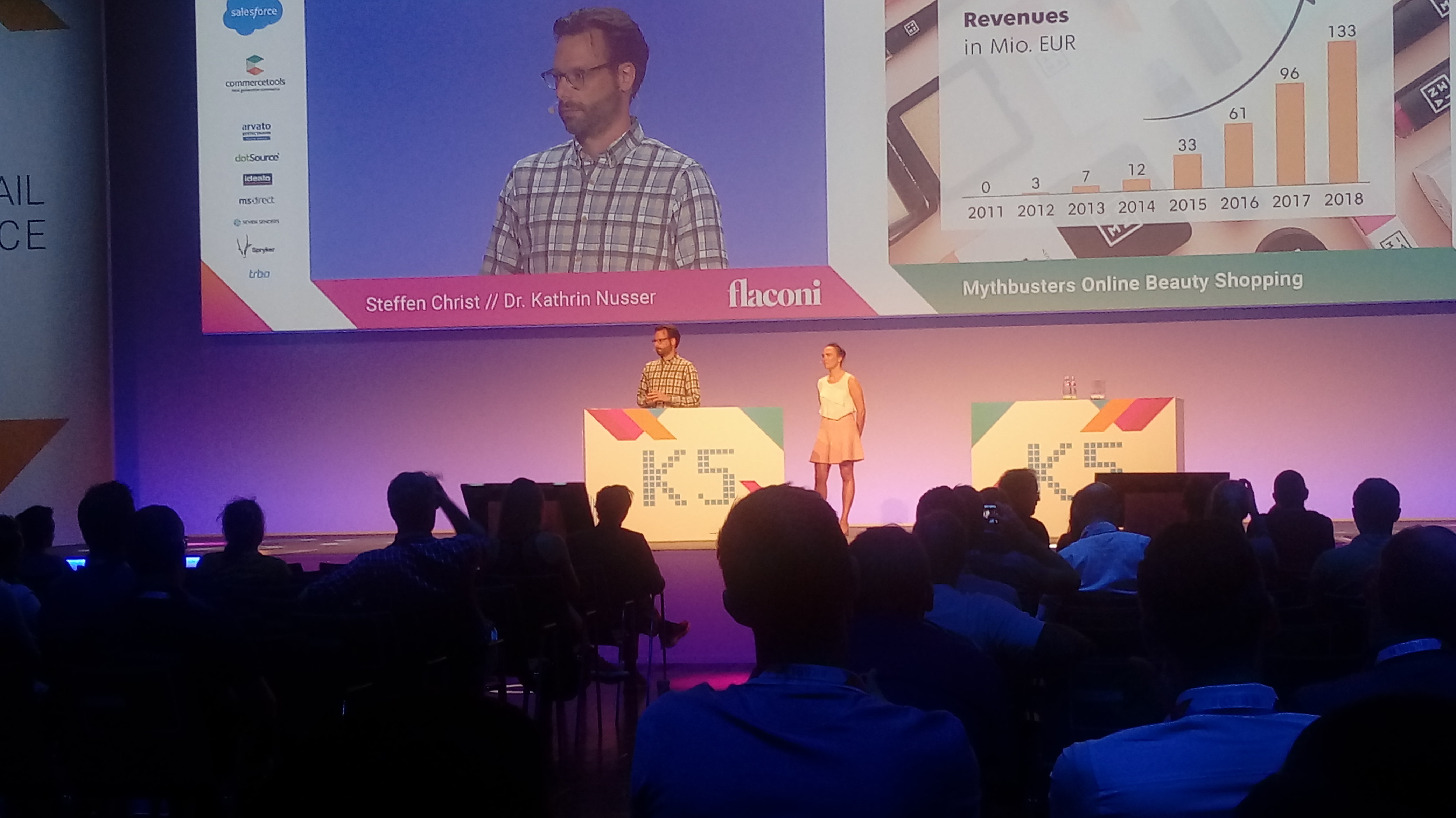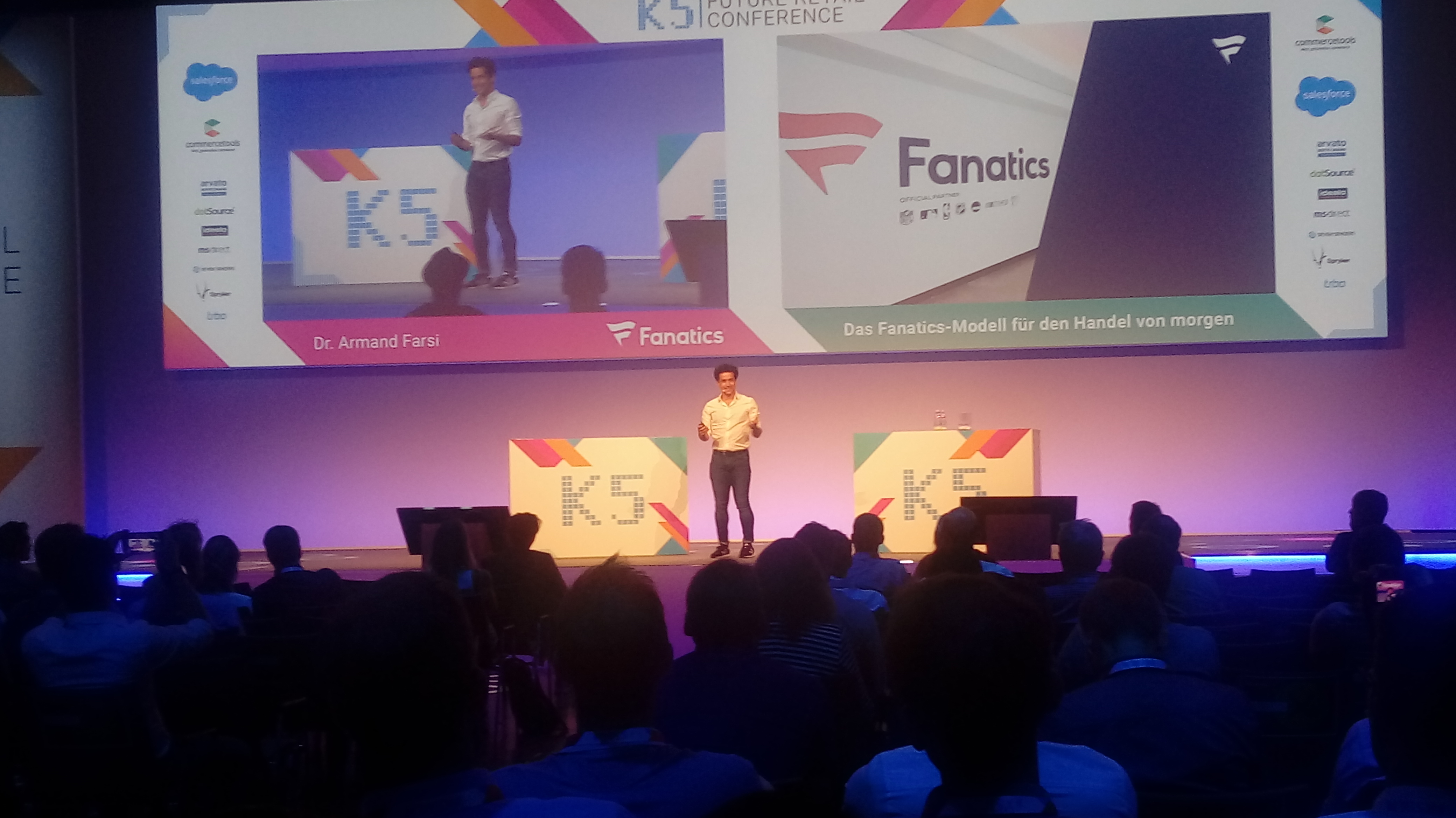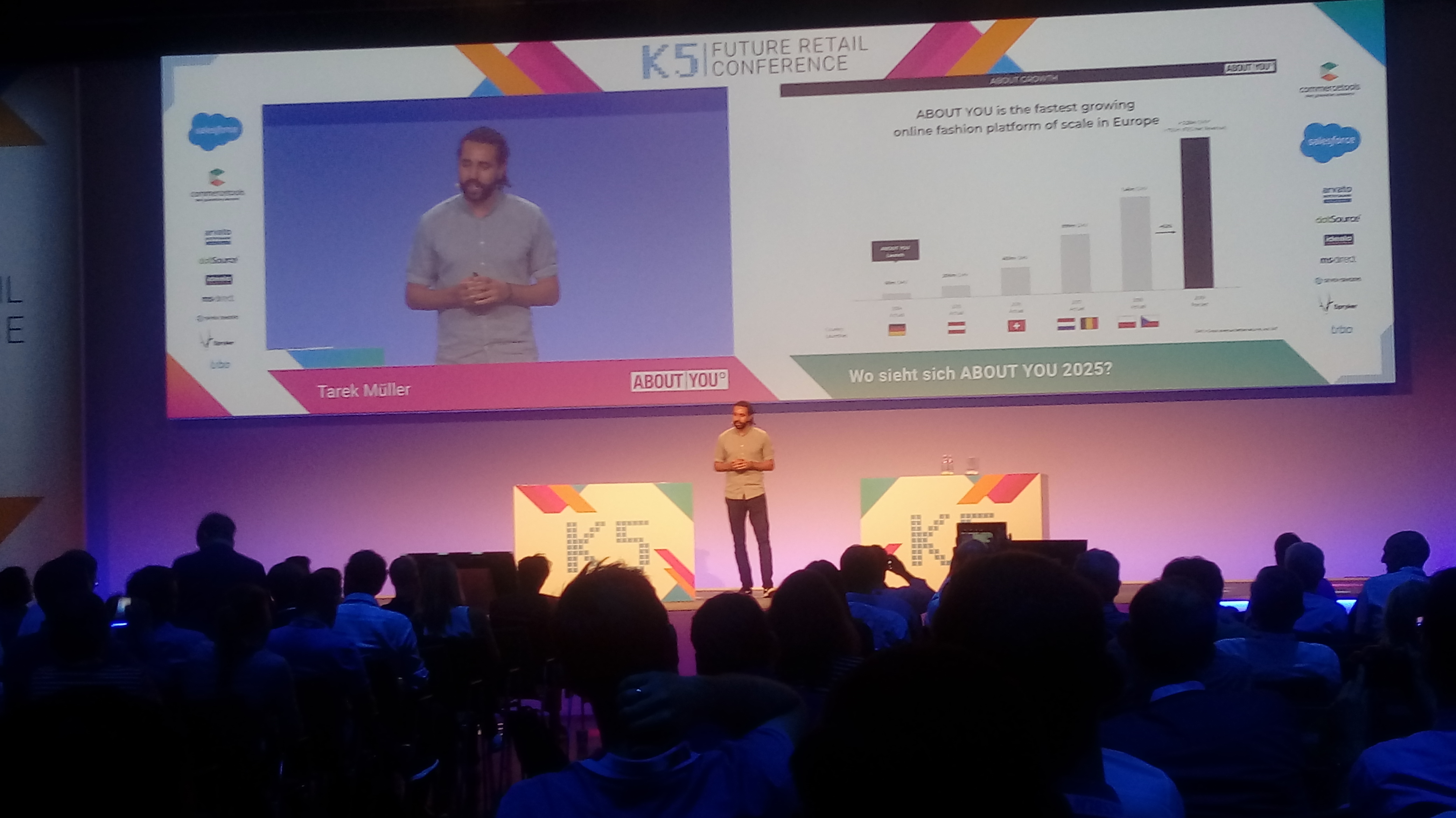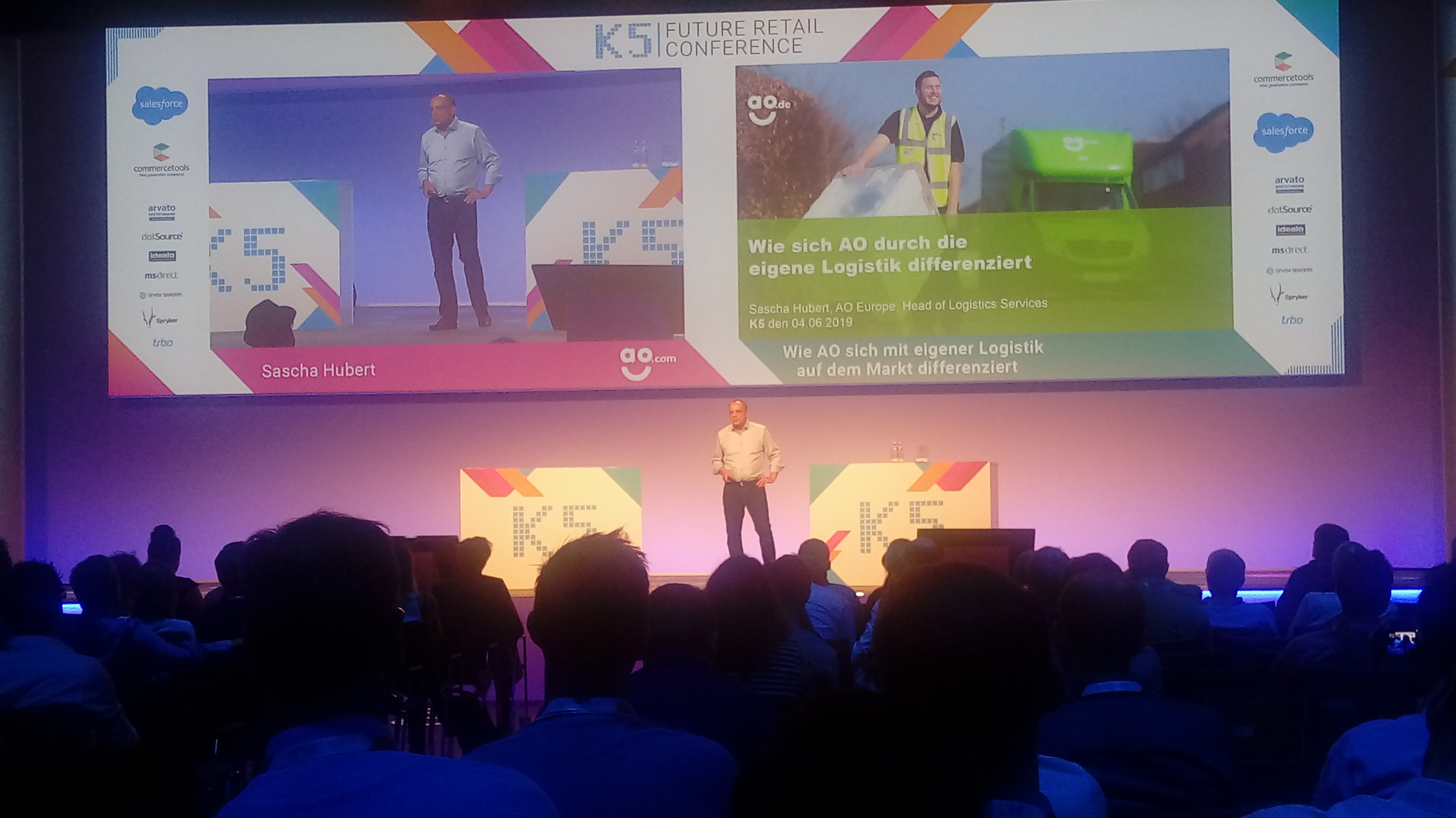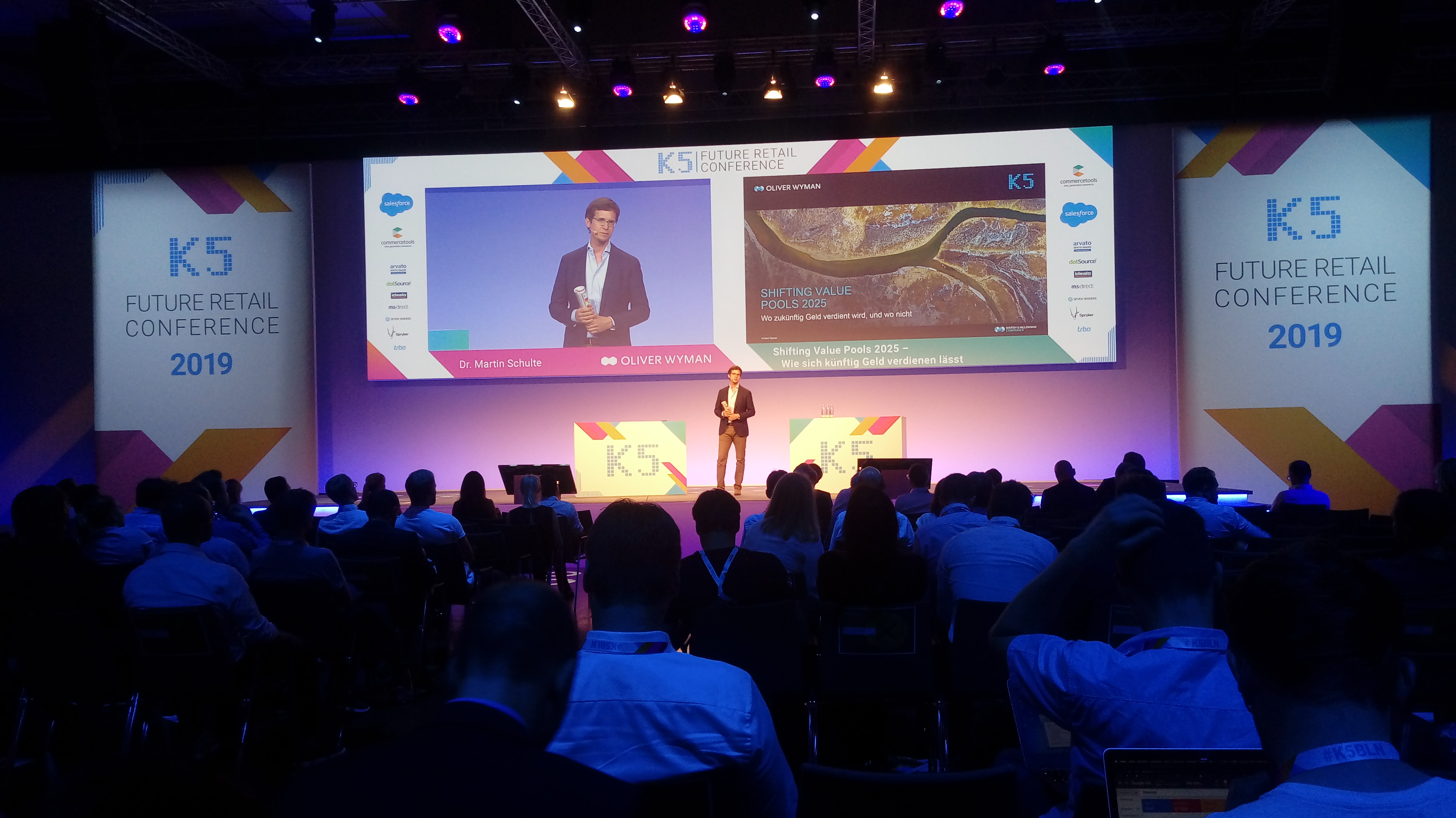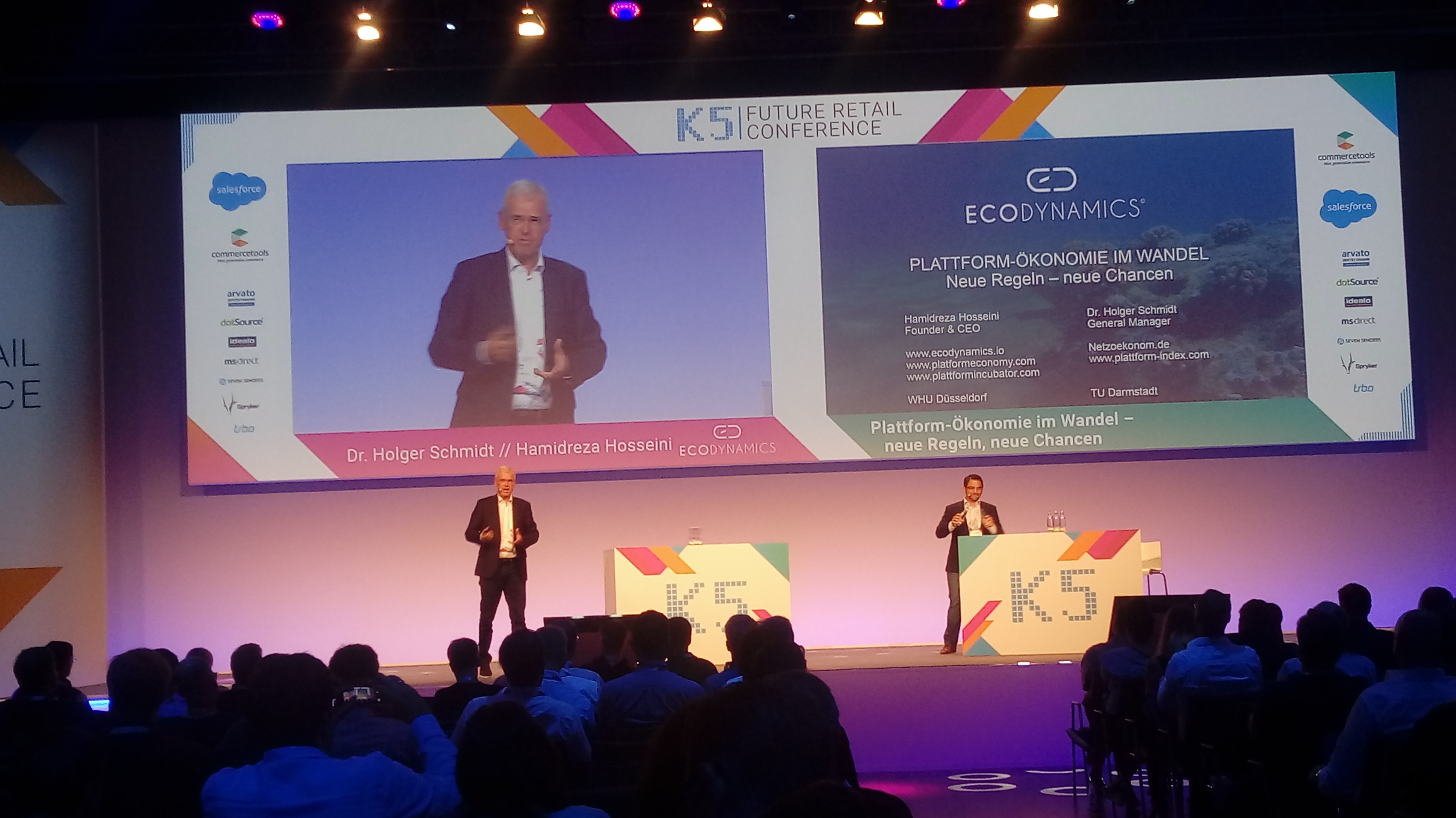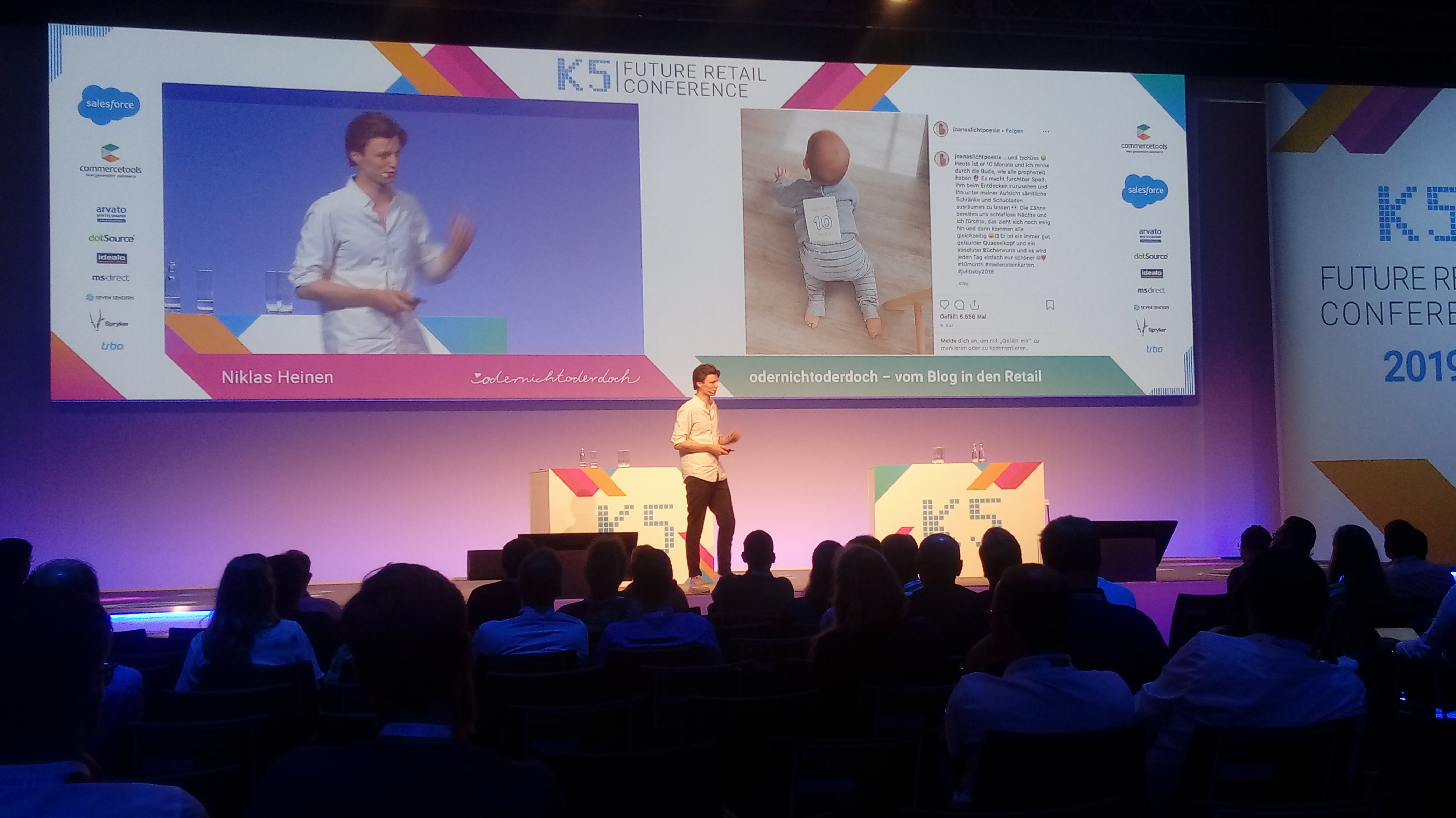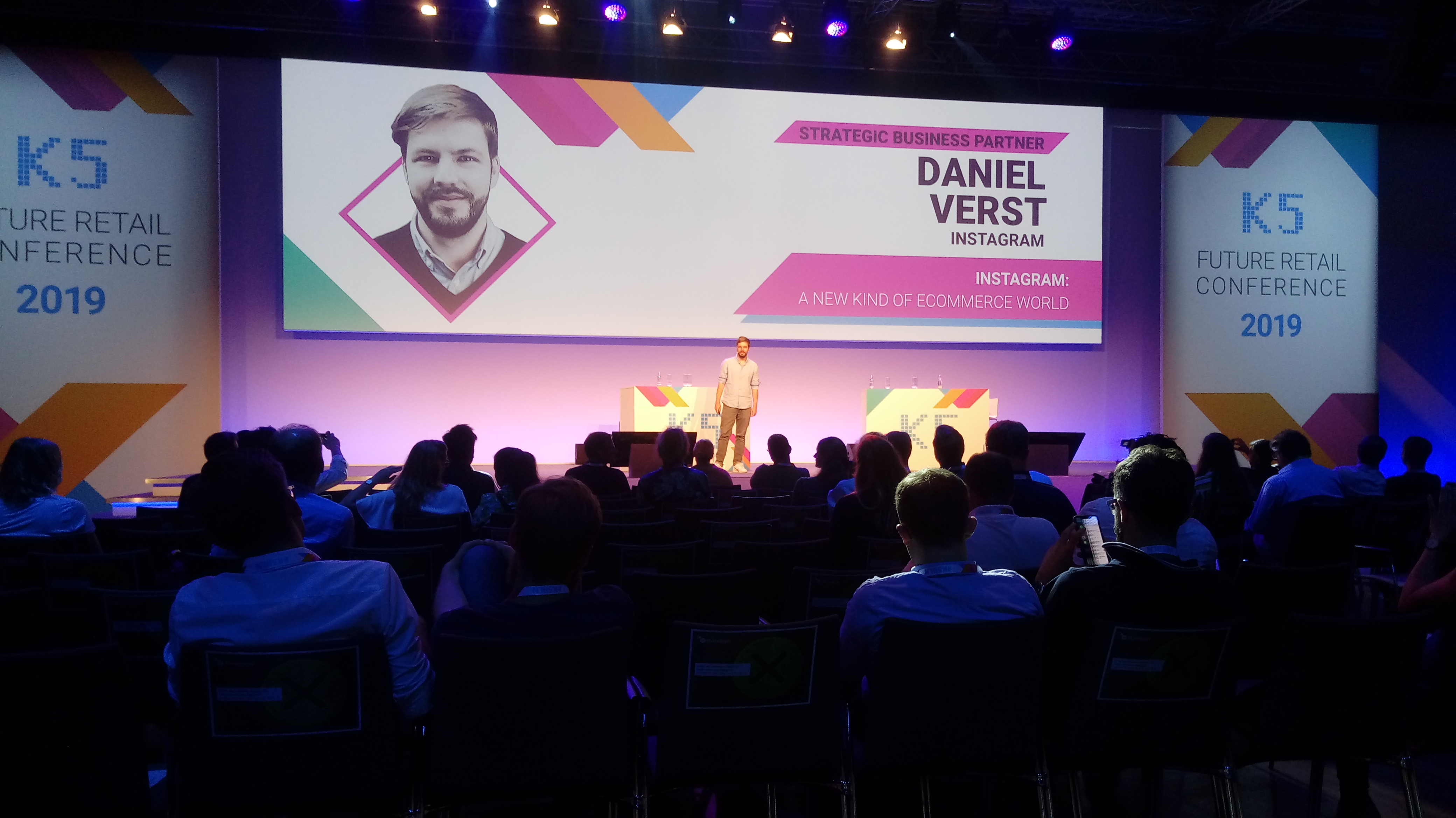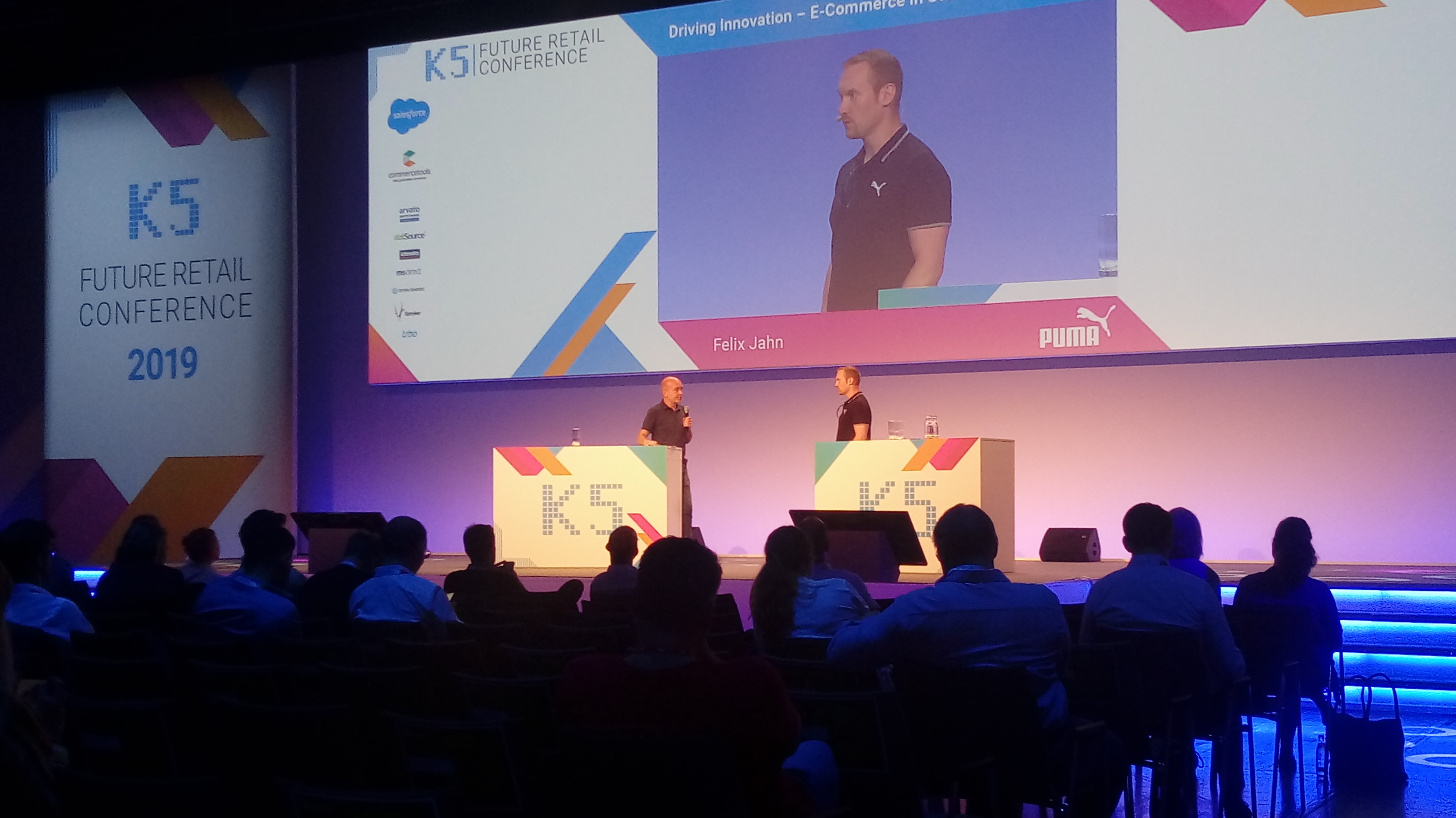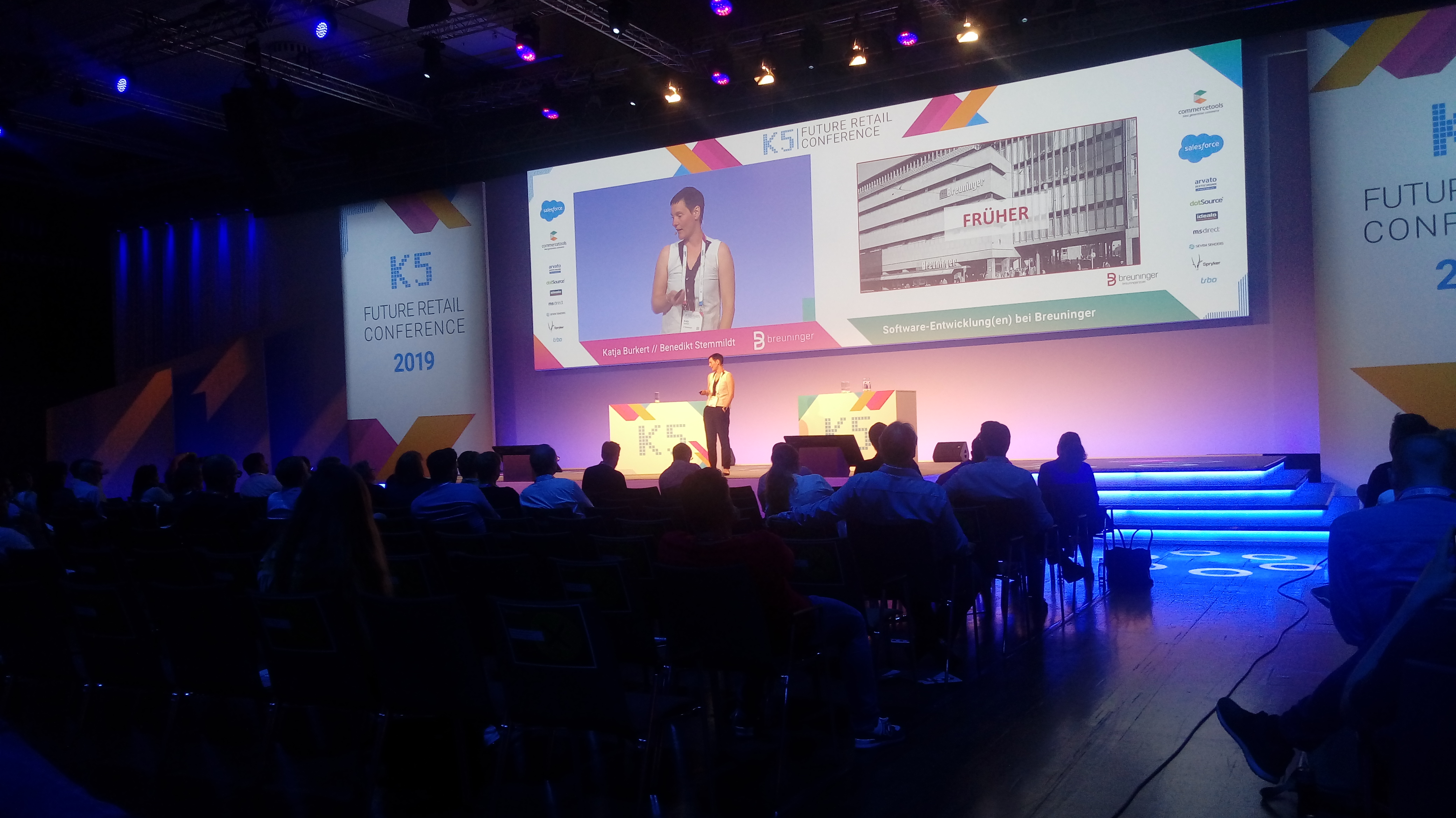Insights from the K5 2019
What opportunities do trading companies have at a time when even Amazon seems to be reaching its first growth limits? To this question the speakers of the K5 tried once again to give their personal answers. In this way, the approximately 3,000 visitors to the event were offered two insightful days full of input and updates from such diverse companies as ABOUT YOU, Picnic and Breuninger. With this article I would like to make the most exciting insights of selected presentations accessible to all those who stayed at home.
Key Subject “Home & Living”
Westwing experiences: Building a brand that sells (Stefan Smalla, Founder & CEO, Westwing)
- Westwing sees itself as a shoppable magazine in which content and commerce are combined. Therefore more than 100 editors are employed and two film studios are operated.
- The aim is to be constantly approached by customers and to inspire them.
- This approach results in great loyalty: 85 percent of sales are generated by customers who are on average 100 times a year on the website.
- In the early days Westwing focused strongly on paid marketing, but since 2015 a shift to organic marketing has been implemented. Influencers in particular are involved in this process.
- Scaling is still the big challenge at Westwing. Therefore, a special focus is placed on the development and expansion of own assets (content, followers, etc.).
- These assets can be used to provide partner brands with a growth channel.
- Hypotheses on how brands must position themselves from now on:
- Every brand must establish D2C channels.
- Brands need to increase their own brand loyalty.
- Social media is real. Brands should therefore focus on this topic.
The Wayfair Recipe: A winning platform for Home & Living (Dr. Malte Dous, Director EU Category Management & Dr. Saskia Meier-Andrae, Director EU Brand, Creative & Promotions, Wayfair)
- Principles of Wayfair:
- Extensive selection to let the customer decide for himself. Wayfair can integrate entire assortments of its suppliers
- Great Tech & Ops capabilities to support suppliers (e.g. packaging, warehousing, 3D imaging, delivery)
- Partnership-based cooperation with suppliers
- Wayfair is also working to improve the shopping experience by
- Tech features like Search-by-Photo, Shop-the-Look, Room planner
- Personalization
- Curating of exclusive brands, establishment of own brands
- Sales activities such as the WayDay
MADE.COM: Building an online design brand for the digital generation (Gemma Comabella, MD DACH, MADE)
- The millennials are establishing new social trends:
- Mass individualization
- Sustainability & Responsibility
- On-demand
- Quality over quantity
- Wellness
- Global vs. hyperlocal
- Based on these trends, MADE sets itself the following goals:
- Provide more value. (Showroom Events, Ideas Hub)
- Be mobile-minded.
- Think social first. (Share inspiring content in the social networks and use the website for informative content.)
- Think responsible.
- Enable Digital Physical Spaces. (Customer contact is important. Stores can also be developed in a tech-oriented way.)
Key Subject “Food”
Focus on the food industry – concepts for today and tomorrow (Dominique Locher, Digital Pioneer & Entrepreneur)
- Three waves in e-commerce
- 1st wave: Easy to digitize products (music, travel, etc.)
- 2nd wave: Products such as furniture
- Food will be the third wave
- Many customers have already tried out online grocery retailing, but the frequency has yet to increase.
- In other countries, the breakthrough has long been there (South Korea: 20 % share of sales, UK and France: about 7 %).
- In these countries, the topic has been pushed by retailers for years. German retailers are still very cautious.
- Amazon has purchased Whole Foods in the USA and has partnered with Casino (France) and Morrisons (UK) in Europe. In this way, Amazon secures customer access, locations and access to the supply chain. It is probably only a matter of time before Amazon looks for such a partner in Germany as well.
- From an Amazon perspective, grocery sales can also be seen as a marketing measure that also helps to establish further business.
- Ocado is also pursuing an interesting approach, having acquired immense robotics expertise in recent years and is now reselling this know-how to Kroger, for example.
Picnic about the first year on the German market (Frederic Knaudt, Co-Founder & CEO, Picnic)
- Picnic sees itself as “the only online supermarket for the mass market”.
- Picnic is based on weekly shopping (average customers order 40 x per year)
- No delivery charges, low minimum order value.
- Picnic now has four delivery hubs on the Lower Rhine. Bochum, another in the Ruhr area, will be added shortly.
- In the existing delivery areas, more than 25% of households installed the Picnic app after 6-12 months.
- How does Picnic learn?
- Being on site (at city festivals, talking to mayors, etc.)
- Customer service (60% of communication is through WhatsApp)
- Experiences of the Runners
- In-app feedback
- Important learnings from the first year
- Assortment and UX: The first shopping basket is the key.
- Operational Excellence: Every order must be complete.
- Personal service through the Runner is enormously helpful.
Customer approach and brand understanding at HelloFresh (Dr. Katharina Buttenberg, VP Global Brand, HelloFresh)
- The procedure of a normal meal: Planning -> Shopping -> Cooking -> Eating
- Hello Fresh wants to give people more time to eat, by
- simplifying planning.
- omiting the purchase.
- simplifying the cooking thanks to simple and quick recipes.
- By eliminating retail, HelloFresh also enables a faster supply chain. From the producer to the end consumer, the goods are only on their way for three days.
- This has some advantages:
- The products are fresher.
- Less food waste is produced because HelloFresh does not hold as large stocks as the retail trade.
- HelloFresh secures a better margin by eliminating the retailers.
- Challenge: The HelloFresh offer is complex and has to be explained. This has an impact on communication.
Key Subject “Fashion & Beauty”
Vente-Privée goes Veepee (Holger Lendner, Managing Director, Veepee)
- Vente-Privée is market leader in online flash sales in Europe, but for some time stagnating sales in Germany.
- In addition, there were some acquisitions (now six companies within the group that are active in 12 countries) -> partly different platforms -> high complexity
- Actions
- One global brand (Veepee in all markets)
- One global platform (increase efficiency)
- One Value Proposition („Pink experiences every day“)
- Connected business (giving partners the opportunity to sell even during the season if the sales figures are not correct, offering marketing services)
- Innovation (e.g. social shopping approach via VeepeeZ)
What makes mytheresa different in the fashion market? (Sebastian Dietzmann, Managing Director, mytheresa)
- Sales in the luxury e-commerce market will double by 2023. So far, the online penetration of the market is still very low.
- Target group: Customers with little time, family and purchasing power.
- She is employed and has an active social life.
- She spends a large part of its disposable income on luxury goods.
- She knows exactly what she wants.
- She has high service expectations.
- She loves her smartphone.
- She is between 30 and 50 years old.
- In the future, the target group will become younger and increasingly come from Asia.
- Strong curation and extremely luxurious positioning are the distinguishing features of mytheresa.
- Customers should be inspired.
- Self-developed content (photos, texts, videos), often in co-production with the brands.
- Exclusive and private events with leading designers and brands for selected customers.
- Customized products, exclusive collections, pre-launches.
- mytheresa is in a global niche.
- Global logistics.
- Global payment methods.
- Customer Service 24/6 in 8 languages.
- Local social media appearances.
Breuninger on new paths (Dr. Sven Bernhardt, CCO, Breuninger)
- Credo at Breuninger: Multichannel is compulsory, channel excellence is the key!
- Multichannel offers: Website, app, in-store ordering service via the employees on the site.
- But channel excellence is the key.
- Offline: Focus on shop windows, events, consulting and service.
- Online: Replacement of the standard software in favor of an own multichannel tech platform, which controls the webshop as well as the apps and tablets of the employees.
- In addition, courage to expand business models (outfit box, flash sales).
- Personalization on the basis of Breuninger-Card data.
Where is Flaconi today? (Steffen Christ, COO & Kathrin Nusser, CFO, Flaconi)
- Myth 1: Amazon is going to take it all.
- Amazon already has everything. Nevertheless Flaconi grows well. Differentiation characteristics: operational excellence and protection against fake products.
- Myth 2: Initial purchase is always offline.
- Flaconi findings show a different picture. Customers can also be inspired online.
- Myth 3: Pure players destroy prices.
- Pure Players create transparency. After a short time, a market price also settles online.
- Myth 4: Beauty e-commerce is only replenishment or deal-hunting.
- The statement only applies to 51 percent of customers. Also inspiration, problem solving, gift buying.
- Myth 5: E-Commerce is for Millennials.
- Flaconi’s customer structure has two peaks: the 20-year-olds and the over-40s.
- The 20-year-olds mostly live in the city and like the wide assortment of Flaconi.
- The over-40s mostly come from rural areas and use Flaconi due to a lack of time or infrastructure on site.
The Fanatics model for tomorrow’s retail (Dr. Armand Farsi, Head of DACH, Fanatics)
- The sports merch industry is very fragmented. In addition, it is difficult to plan how much inventory you need. In the Bundesliga, the share of merchandise in total sales is also declining.
- Fanatics is therefore pursuing an innovative vertical model.
- Securing all rights of the Verticals
- Focus on Tech & Data
- Fast product development
- Agilisation of the supply chain
- Expansion of D2C channels
- Massive Assortment
- In this way, Fanatics has increased its turnover tenfold over the past six years (to 2.5 billion US dollars).
- Projects for the coming years
- Further growth and expansion of the global footprint
- Improvement of infrastructure (tech, production, supply chain)
- Implement milestone partnerships with NFL, MLB and Nike
- Build more exclusive partnerships
Where does ABOUT YOU 2025 see itself? (Tarek Müller, Co-Founder & Co-CEO, ABOUT YOU)
- According to Tarek Müller, there are three categories in fashion e-commerce:
- Buy Fashion -> mainly covered by Amazon
- Find Fashion -> mainly covered by Zalando
- Discover Fashion -> here ABOUT YOU sees itself; the Saturday stroll is to be digitized.
- The challenge is brand building. ABOUT YOU can no longer orientate itself on Zalando, which became known through TV commercials, because the media use of customers has changed. There’s a commercial saturation.
- Solution: Do not focus on advertising, but on content.
- ABOUT YOU is now the largest fashion media house in Europe.
- Cooperation with influencers, as the young target group consumes social media rather than TV.
- ABOUT YOU also taught itself how to produce events (e.g. ABOUT YOU Awards).
- In addition, lifestyle campaigns are implemented with other brands.
- Long-term ambitions:
- Become the market leader for fashion e-commerce thanks to the ABOUT YOU platform.
- Remain the largest fashion media house in Europe.
- Further establish the ABOUT YOU cloud.
Key Subject “Logistics”
How AO differentiates itself on the market with its own logistics (Sascha Hubert, Head of Logistics Services, AO Germany)
- Logistics is the most personal touchpoint. For this reason, AO tries to differentiate itself by this and to offer a very good service at this point.
- AO has a central warehouse, 15 depots and a delivery fleet of 150 vehicles in Germany.
- AO takes care of consulting, installation and disposal.
- In the area of delivery, AO can offer Next-Day-Delivery. Products are picked and loaded at the central warehouse on the same day as the order is placed. The products are then distributed overnight to the depots, from where they are delivered to the customer the next day.
- The customer chooses his desired date and can change it later. In addition, the customer is called 20 minutes before the arrival of the goods.
Key Subject “Platforms”
Shifting Value Pools 2025 – How to make money in the future (Dr. Martin Schulte, Partner for Retail & CPG, Oliver Wyman)
- The rules of value creation are shifting.
- Through new consumption habits (use instead of possession)
- Through new value pools
- Three levels of value pools
- Concentrated value pools (physical goods)
- Distributed value pools (apps, services etc. around the physical good)
- New ecosystems in which the product and the brand are only a small part.
- In Germany, only 4 percent of GDP is generated by new value pools. Established players usually only verticalize their business. Germany is too slow.
- Forecast until 2025: 17 percent of global GDP is generated by new value pools. Retail and manufacturers will lose shares.
- In particular, classical retail will face problems. Growing value creation in this segment is mainly generated by D2C channels and microbrands.
- Conclusion:
- Germany is missing a trend.
- New value pools have high commercial potential and secure the customer interface.
- Too few impulses towards new revenue streams.
- The chances of survival of pure retailers are declining increasingly.
- Retailers must be more than just retailers.
- Business models must focus on customer benefits, not the channel discussion.
- Secure the customer interface in the long term.
- Manufacturers and retailers should finally enter into reliable partnerships.
Changing Platform Economy – New Rules, New Opportunities (Holger Schmidt, Digital Economist & Hamidreza Hosseini, Founder & CEO, ECODYNAMICS)
- Since 2012/13 there has been a drastic increase in risk capital in digital companies – especially in the mobility and food sectors.
- Amazon: Growth in proprietary trading is slowing somewhat. However, this development is cushioned by the platform business.
- Amazon is currently investing heavily in logistics: 72% of US citizens can already be supplied within a maximum of one day.
- Alibaba has taken the platform idea a step further and built up a rich ecosystem of services (cloud, online marketing, finance, logistics, social networks, etc.).
- The 70 largest platforms in the world already generate 7.3 trillion euros. This means that 9 to 10 percent of world GDP has already migrated to the platform economy. With a share of 3.8 percent, Europe is lagging massively behind the USA (67.7 percent) and the Asia-Pacific region (27.2 percent). Is there still time to catch up on this lead?
- The platform business model displaces the product business model.
- Before 1998: Classic linear product business model (Classic Sales, E-Commerce etc.)
- 1998-2004: 1st generation platforms (marketplaces as intermediaries)
- 2005-2012: 2nd generation platforms (monothematic share economy)
- 2013-2019: 3rd generation platforms (information-economic and ecosystem-driven platforms)
- From 2020: 4th generation platforms (AI, API, ecosystem driven)
- Three go-to-market strategies in platform business
- Build your own platform (very capital-intensive)
- Build a Platform in the Alliance
- Using existing platforms as sales channels
- The principle of hope, on the other hand, is not a strategy.
- In the B2B business there are also first promising approaches in Germany. These must be followed up.
Electronics and the platform economy – Where is the journey heading for the sale of smartphones, television and Co.? (Dominik Dommick, CEO, Payback / Oliver Merz, CFO, Lampenwelt / Heiner Kroke, CEO, Momox / Rob Peters, Director Marketing & Sales, Teufel / Host: Joel Kaczmarek, CEO, digital kompakt)
- Momox has backtracked from the electronics retail. Problems for Re-Commerce in this segment: frequency, high purchase prices, inspection of the goods is complex, no quick turn.
- From Dommick’s perspective, there is no single electronics market. The price pressure and the achievable margins are very different between the individual fields. Payback can help with marketing and loyalty building.
- There is hardly any brand awareness in the lamp market. This is why Lampenwelt works strongly with its own brands. In addition, mass market rather than the sale of premium goods takes place online.
- Teufel sells mainly through his own online shop, but is also active as a seller on Amazon. The strategy is customer-centric: Serving the customer where he is.
- Momox is also agnostic. The development of the company’s own website is being driven forward, as is sales via marketplaces.
odernichtoderdoch – from blog to retail (Niklas Heinen, Founder & CEO, odernichtoderdoch)
- odernichtoderdoch was originally a blog in which Joana Heinen shared her feelings with her fellow human beings from 2011.
- Coupled with girlish imagery, the blog’s texts reached more and more people. Joana Heinen thus became an influencer without explicitly wanting to do so.
- Question: What do you do with this range?
- First, desk pads and calendars were designed. Especially the calendars were not well produced in the beginning. Joana therefore decided to send handwritten letters of apology to the customers. -> Convince with instinct and authenticity.
- Today, however, odernichtoderdoch stands for an eight-figure turnover.
- As a social e-commerce brand, followers and customers are actively involved in product development. In this way, the value of “interaction” is introduced into the brand in addition to gut feeling.
- In the meantime, however, the company is also working on a stationary roll-out (pop-up shops, cooperation with brick-and-mortar retailers).
Instagram: A new kind of ecommerce world (Daniel Verst, Manager E-Commerce, Instagram)
- Instagram sees itself as a “home of visual expression” for private individuals, celebrities, publishers and companies. -> Companies have thus been an integral part of the platform from the very beginning.
- 2010: Photos -> 2013: Videos -> 2016: Stories.
- E-commerce is now the next logical step. Instagram has over 1 billion monthly active users. 80 percent of them follow at least one business account. Users also use Instagram along the entire purchase journey.
- So far, there have been many frictional losses when users wanted to buy products they saw on Instagram. Instagram Shopping should prevent this.
- Advantages of Instagram Shopping:
- Simplicity (Postpone photos with products)
- Storytelling (Stories, videos, photos)
- Scale (Explore, Shop on Profile)
- There will also be a checkout on Instagram.
Key Subject “Tech”
Driving Innovation – E-Commerce in Store (Felix Jahn, Head of E-Commerce Europe, Puma)
- Puma is not an Internet pure player. This means that e-commerce had to fit into structures that were decades old.
- In the meantime, e-commerce is no longer seen as an enemy in one’s own house.
- The question of cannibalization does not arise from Jahn’s point of view. If Puma is not present at the relevant touchpoints, no Puma products will be sold there.
- In addition, e-commerce also has advantages: Puma finally gets access to unfiltered end customer data.
- Strong focus on linking e-commerce and the stores with each other. For this purpose, relatively small investments are made again and again and dynamically experimented.
- Sales distribution issues are deliberately placed at the back so that all those involved can first taste blood.
- Puma tries to standardize the strategies for the stores to some extent, but of course it also needs individual approaches. A store in which many tourists shop, for example, needs different payment methods than a store with a high proportion of local regular customers.
Software development at Breuninger (Katja Burkert, Head of Software Engineering, Breuninger)
- In the beginning Breuninger operated his online shop as a monolith for which standard software was used. The time to market for new features was correspondingly long. Only every three to four months a new release was brought live.
- However, there has been a technology push in the market environment: More and more information that has to be processed leads to increasing complexity.
- Solution: Introduction of a new platform that scales through functional decomposition.
- Separation of verticals on the basis of the customer journey (e.g. search, discover, buy etc.) into self-contained systems
- Professional knowledge becomes manageable again
- Teams are each responsible for one vertical, becoming experts
- In addition, the technology that makes the most sense for the respective vertical can be used. Partially but also shared libraries.
- Architectural principles
- Page Assembly: SSI vs. AJAX
- Redundancy: Each vertical must hold used data itself.
- Synchronicity: There are several data owners and a pull principle: Verticals must obtain their data from the respective owner.
First published on www.innovation-implemented.com

